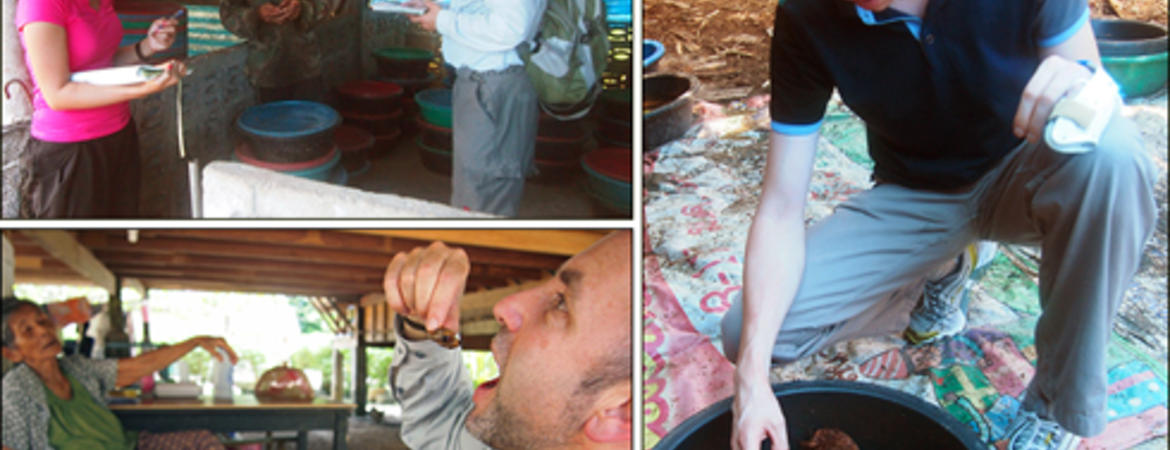
Article by Mark S. Hoddle, Department of Entomology, University of California, Riverside CA 92521, USA
Background: Entomophagy is the consumption of insects by humans for food. This is an ancient practice that tends to be concentrated in certain parts of the world, notably tropical and sub-tropical regions, where there is a diversity of large insects that are suitable for eating and which also have long windows of availability, this may sometimes be year round for certain species. Insects are touted by enthusiasts and some NGO’s and global humanitarian organizations (e.g., FAO) as readily available super foods because they are excellent low cost sources of protein and essential nutrients. Edible insects can often be sustainably harvested from wilderness areas and have very low carbon footprints if farmed for personal consumption or as a commercial enterprise. Due to interest in eating insects because of their nutritional and environmental benefits, and given the fact that a wide diversity of insects, probably many tens of species across several orders (e.g., Coleoptera [beetle larvae and pupae], Hemiptera [ giant water bugs and cicadas], Hymenoptera [ants and bees], Isoptera [termites], Lepidoptera [moth and butterfly larvae and pupae], and Orthoptera [cricket, grasshoppers, and locusts]), are eaten by daily by millions of humans, there is interest in the viability of mass collection, production, or farming of certain species for food. This is already being done in some areas, with a notable example being the mass collection and subsequent preparation and sale of chapalines, a type of grasshopper, in Oaxaca, southern Mexico. Another insect that has significant potential for mass production or farming are palm weevils. Larvae and pupae of these species are widely eaten in southeast Asia and farmed to a limited extent in some countries, notably Thailand.
The Hult Prize and the Clinton Global Initiative: On Monday 23 September in New York City, the Clinton Global Initiative awarded the Hult Prize worth $1 million(US) to a team of MBS student entrepreneurs from the Desautels Faculty of Management at McGill University in Montreal Canada. The winning pitch made by this team was to combat hunger and nutrition deficiencies in impoverished regions by improving diets with insect-based meals. As part of the development McGill’s entomophagy project, Gabriel Mott (McGill) together with Mark Hoddle (UCR) traveled to Thailand together over 14-19 September 2013 and with the help of Nittaya Ummarat, a post-graduate researcher at the UC Kearney Agricultural Research Center, assessed red palm weevil farming practices for possible translation to west Africa where palm weevil are eaten, but they are not farmed.
KCRW 89.9: Mark Hoddle talks with Evan Kleiman, host of Good Food, about the Clinton Global Initiative’s award. [Interview starts at 12 minutes] Listen Download
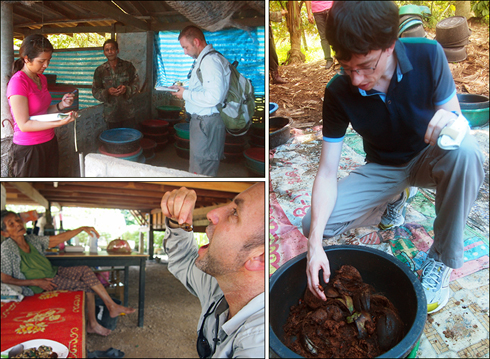
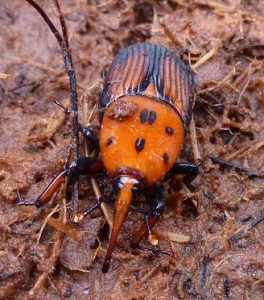
Palm Weevil Biology – An Overview: Palm weevils, Rhynchophorus spp. (Coleoptera: Curculionidae), are equatorial in distribution and there are approximately 10 described species. Rhynchophorus weevils are remarkably similar in their biology and ecology regardless of what country or region they are native too. First, the immature stages all feed internally on palms. Feeding activity is typically concentrated in apical regions (i.e., palm crowns of coconuts) where meristematic tissue is present and then feeding larvae burrow down into the top portion of the trunk (an exception to this are attacks on date palm trunks where the majority of attacks occur within 1 m of the ground). This feeding strategy invariably kills infested palms, and in many regions (native and non-native ranges) palm weevils are considered pests when they attack and kill palms of economic (i.e., human food sources) or aesthetic (i.e., ornamentals in urban areas) value. This feeding pattern is typical of R. ferrugineus, the red palm weevil, and R. palmarum, the South American palm weevil, both of which are well recognized pests of coconut palms, and in areas where they are invasive, similar destruction of exotic ornamental Canary Islands palms is observed. Second, all Rhynchophorus weevils have large larvae that feed internally inside palm trunks. The entire life cycle of immature stages is concealed – larvae feed inside palms and pupae are protected within fibrous and extremely tough cocoons that occasionally fall to the ground from infested palm trees. Third, adult weevils, are large, long-lived (several months), and very vagile. Adult palm weevils release aggregation pheromones that attract males and females of the same species to palms that are undergoing attack. Consequently, palm attack intensifies over time due to recruitment of reproductively active adults looking for mates and egg laying sites and development of increasing larval populations that result from females laying eggs. Infested palms release airborne volatiles that when combined with aggregation pheromones, act synergistically in recruiting adult palm weevils.
The life cycle of palm weevils is simple. Female weevils lay eggs inside holes that they make in suitable areas (e.g., bases of palm fronds where they attach to the palm crown) with their long snout or rostrum. Weevil larvae hatch from eggs and burrow into the palm where they commence feeding. Larvae pass through several developmental stages, the exact number seems to vary and may be related to food quality, and probably human uncertainty in accurately classifying larval life stages. As larvae feed, they turn palm material into a fermenting mash. The odor of this material is very obvious and has a characteristic signature once you are aware of it. It is likely that there are important symbiotic relationships between a variety of bacteria that are associated with fermenting palm material and weevils, and these microbes may be necessary for weevil larvae to exploit palm material. Additionally, it is possible that palm weevils have evolved special adaptations that allow them to live in this extremely warm and damp environment yet somehow escape organisms that cause disease epidemics. There appear to be no reported epizootics killing high densities of weevil larvae living inside palm trees (it is possible these have been overlooked because they occur inside palms and would be very difficult to observe, but lots of dead larvae and pupae would be obvious if detected and considerable work on several palm weevil species has been conducted in the field). Once larval development is complete, pre-pupal larvae spin tightly woven cocoons from palm fibers within which they pupate. Cocoon spinning requires larvae to be wedged into a substrate upon which sufficient purchase can be attained to allow the larva to simultaneously rotate and spin palm fibers into a cylindrical, cigar shaped cocoon within which they will pupate. Upon completion of pupation, adult weevils emerge and they may breed within the palm host they occupy or they could disperse to new areas. When suitable host palms are nearby weevil flight appears to be limited in distance and attacks on neighboring palms are more likely to occur and attacks are thus aggregated in distribution. In the absence of near neighbors, weevils can fly significant distances, > 20 km in a 24 hr period, to find host palms. When suitable breeding sites are present adult weevils are reluctant to leave and they exhibit high levels of thigmotaxis, that is, they have a strong behavioral trait to secret themselves into concealed and difficult to access protective crevices in palms. Dislodging adults from these hiding sites is extraordinarily difficult and can sometimes result in physical damage to adults.
Palm weevil larvae, pupae, and adults are used for food in many equatorial countries where these weevils are native, most notably in southeast Asia (e.g., Thailand, Indonesia, Malaysia, and Papua New Guinea) and parts of South America. Palm weevil consumption is advanced in Thailand with mass production of larvae and pupae for eating, and adults being sold to initiate colonies by other farmers.
Red Palm Weevil Farming in Thailand: Over the period 14-19 September 2013, red palm weevil (RPW) farming around Trang in southern Thailand was studied to better understand production practices. Three different farms were visited and two different farming techniques were observed: (1) ground palm material contained in plastic bins (2 farms) and (2) use of rounds of palm trunks (1 farm) for rearing RPW.

Containerized Production of Red Palm Weevils: RPW can be readily grown from eggs to adults in large round plastic containers that would normally be used as basins for holding water or animal feed. Palm material, either mechanically shredded central portions of sago palm trunks (the outer bark is sliced off and used to cover the palm mash in basins [see below for more details]) or the shredded rachis of coconut palm fronds (the leaflets are sliced off with a machete and removed, as is much of the outer green epidermis covering the rachis). Coarse chips of palm material and slices of palm trunk bark are soaked liberally in water in basins. After 3 days, water is drained, the mash is hand squeezed to remove excess water and approximately 500 g of pelleted pig food (made of rice husks, corn, soy bean, sunflower seeds, and peanuts) is added to the palm mash and stirred in. Adult weevils either collected from infested palms in the wild or reared previously are used to inoculate containers with palm mash. Three male-female pairs are introduced per container and removed after 15 days. Adults are then combined to make groups of 5 pairs and used to inoculate new containers. Adults may be discarded after two rounds of container inoculation. Once adults are added to containers, the mash is covered with the slices of water-soaked palm trunk bark that was removed prior to grinding the heart of the sago palm trunk. These bark slices provide protective cover for adult weevils so they don’t fly away and later they provide the substrate and long palm fibers needed for cocoon spinning by mature larvae.
Economic Returns from Containerized Rearing: After approximately four weeks (harvest may begin as early as 17-20 days post inoculation with adults) larvae are ready to be harvested and each ~30 liter container can yield up to 2 kg of larvae (1 kg = approximately 150 large weevil larvae). All life stages of the weevil are utilized: Larvae are sold for 250 Thai Bhat per kg ($1US = 32BHT), pupae = 400BHT/kg, adults are sold individually for 3BHT.
RPW rearing is a low cost enterprise in terms of supplies and labor, and production supplements other income streams. One farmer (a rubber farmer in Songkhla Province; other weevils farmers main income streams were from rice and oil palm production or in one case the rubber plantation had been converted to oil palms and weevil farming was the family’s only income until oil palms began production) estimated that 12 rearing containers cost 460BHT, 1 kg of pig food amendment cost 32BHT, sago palm was harvested locally for free (one farmer in Nakhom Si Thammarat Province who grew RPW to sell adults to other farmers bought rounds of sago palm trunk at a cost of 1000BHT for 25 pieces each being 0.5 m tall), and just a few hours of work per week were needed to manage the rearing program.
At the weevil farm in Songkhla Province, containers of RPW larvae were stacked on shelves in a cinder block storage shed (the shed lacked temperature, humidity, and light control). The storage space, approximately 30 m2, held 130 bins stacked vertically in columns of 2-3 containers on shelves. A rough estimate based on the data above suggests that if each bin produced 2 kg of RPW larvae at 250BHT/kg, this would yield 260 kg/mo and 65,000BHT (or about $2,000US assuming all larvae are sold), which equates to a return of about $24US/m2 of rearing space. The production statistics could not be verified during this field trip, but the price per kg of larvae cited by weevil farmers was consistent at around 250BHT/kg. Mass production of RPW would appear to very profitable, but realized returns may be lower than estimated here due to variable demand. A second farmer in Nakhom Si Thammarat Province, indicated that daily sales could very variable, ranging from 0-1 kg sold per day up to 10+ kg/day if religious festivals and holidays were being observed. Infrastructure costs to house rearing containers may actually be very low too.

Low Cost Rearing Structures: A rearing shed is probably not needed as long as containers are protected from rain to stop them accumulating excessive water from rain events. A tarpaulin tied between trees may be sufficient to provide shelter from excessive rain and sun events and will still allow adequate air flow over containers. The mash in which larvae are grown is highly saturated and modest rain accumulation would likely be tolerable. Year round ambient temperatures in tropical areas, like south Thailand, are likely suitable for weevil farming, and low temperature events, should they occur, may in part be significantly offset by heat given off by fermenting palm mash in which weevil larvae are developing.
Palm Trunk Rearing: One weevil farming operation in Nakhom Si Thammarat Province used rounds of fan palm trunks (Corypha umbraculifera) approximately 0.33-0.5 m tall for rearing. Rounds were purchased at 120BHT each. Individual rounds were placed under crudely built shade structures and on top of each round fermenting palm mash was placed to a depth of about 2-3 cm. Adult RPW were placed on the mash and then covered with flaps of palm bark that was pushed firmly into the mash thereby providing a protected space for the adults live, feed, and lay eggs. No preparation of palm trunks other than the application of palm mash and bark pieces is needed for this rearing set up. After approximately 3 months the first crop of weevils is ready to be harvested, and each palm round can produce larvae for up to 6 months for a total production of about 3 kg of larvae. This farmer preferred the flavor and texture of weevil larvae and pupae produced from fan palm trunks and weevil development is slower and palm trunk longevity is greater when compared to a similar set up with sago palm trunk sections.
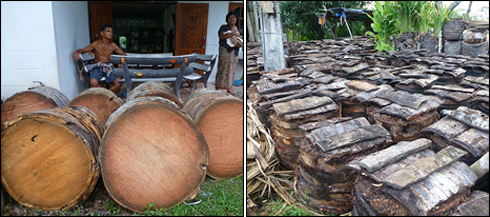
Cost Comparisons of Weevil Larvae to Other Protein Sources: Weevil larvae are sold for 250BHT/kg and pupae retail for 400BHT/kg. To determine price competitiveness, the per kg prices for other protein sources being sold in nearby super markets was determined: fish 69-250 BHT/kg (price was dependent of fish species), chicken breast (with skin and bone or skinless-boneless) 128-180 BHT/kg, and pork (cured) 215BHT/kg. In comparison to these protein sources, locally-grown weevil larvae and pupae are expensive. Interestingly, one customer in Nakhom Si Thammarat Province who was purchasing 2 kg of weevil larvae to feed 5 people said the product was good value for money, affordable, and was a staple monthly dinner item.
Preparation of Weevil Larvae and Pupae for Eating: There are three main ways RPW larvae and pupae are prepared for eating: (1) stir-fried in a wok (very common), (2) prepared as a curry dish with vegetables, or (3) battered and deep fried. Sometimes live larvae may be eaten after floating in soy sauce. Cooked RPW larvae and pupae provide a substantial and hearty meal either on their own or when supplemented with additional vegetables and rice or noodles.
To prepare weevil larvae for cooking, larvae and pupae are soaked for approximately 10 min in a ~10% brine solution. Larvae are drained and blanched for 1 min in boiling water after which the head capsules of larvae may be removed prior to cooking. Larvae are added to a hot wok with vegetable oil and stir fried with Thai basil, finely chopped hot chili peppers, salt, black pepper, and soy sauce. Larvae are cooked until they start to turn a light brown in places (approximately 5 mins). This preparation may be eaten as a finger food snack with cold beer or as a main course with rice. The head capsules of stir fried larvae are crunchy, similar to small sunflower seeds, and add texture to the mouthful. RPW pupae are exquisite, there is no crunchy head capsule, the fat content is high, and the texture and consistency is similar to butter. Deep fried larvae are excellent, and without the head capsule the consumer would be unaware that the morsel was an insect larva and the dish could be easily passed off as calamari or some type of sea food.
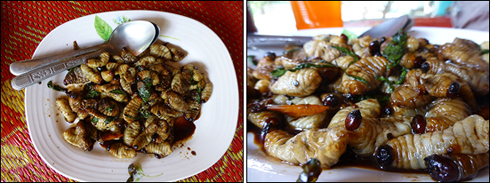
Product Added Value: In addition to producing food, palm weevil farming has several very useful by-products that can be sold. First, the mash used to rear weevils can be sold as compost to amend soils. Second, the spent mash if set up in special storage areas can be left to drain and this “water” can be collected and sold as fertilizer, similar to worm water fertilizer that is collected from worm composting facilities. Third, in the case of using palm logs for rearing, the hollowed out palm trunks can be cleaned up and sold as containers for growing plants.
Summary: Weevil larvae are very easy to farm, production costs are low, and profit margins are potentially high. There is uncertainty concerning the consistency of market demand in some areas, this seemed to be the case in rural areas in Thailand where these field surveys were conducted, and where weevil production is concentrated. Sales can fluctuate and may be driven, in part, by significant religious or holiday events. Palm weevils are well suited to artificial containerized rearing. This is probably not surprising since the container in which weevil larvae are reared is functionally equivalent to a palm trunk within which weevils would normally breed. Preparation of weevils, especially larvae, for cooking is straight-forward and because larvae lack legs and antennae for example, it is easy to “disguise” the fact that they are insects when prepared for consumption. This is especially true when larvae are battered and deep fried. Cooking weevil larvae and pupae in creative ways, and perhaps developing a catchy marketing name, may enhance marketability and acceptance as a food, especially in areas where entomophagy is uncommon or insects are viewed as unclean and unsuitable for eating.
Background Reading on Entomophagy and Red Palm Weevils
- Dembilio, O., Jacas, J.A. 2011. Basic bio-ecological parameters of the invasive red palm weevil, Rhynchophorus ferrugineus (Coleoptera: Curculionidae), in Phoenix canariensis under Mediterranean climate. Bull. Entomol. Res. 101, 153-163.
- Dembilio, O., Tapia, G.V., Téllez, M.M., and Jacas, J.A. 2012. Lower temperature thresholds for oviposition and egg hatching for the red palm weevil, Rhynchophorus ferrugineus (Coleoptera: Curculionidae), in a Mediterranean climate. Bull. Entomol. Res. 102, 97-102.
- Edible Insects: Future Prospects for Food and Feed Security available here.
- Faleiro, J.R. 2006. A review of the issues and management of the red palm weevil Rhynchophorus ferrugineus (Coleoptera: Rhynchophoridae) in coconut and date palm during the last one hundred years. Int. J. Trop. Insect Sci. 26, 135-150.
- Murphy, S.T., Briscoe, B.R. 1999. The red palm weevil as an alien invasive: biology and the prospects for biological control as a component of IPM. Biocontrol News and Inform. 20, 35N-46N.
Crickets vs. Palm Weevils for Mass Production for Human Consumption: Several advantages exist for palm weevil mass production over crickets. First, relatively few weevil larvae are needed to provide a very hearty meal and the texture is very agreeable, this increases greatly if pupae are eaten. Second, weevil larvae can prepared in a variety of different ways for consumption (e.g., deep or stir fried, curries, or even raw), and in comparison, preparation options for crickets may be more limited (unless they are ground into flour which is then used for cooking). Third, weevil larvae are more amenable to being “disguised” in food as they have no legs and antennae, and heads can be easily cut of prior to cooking. Fourth, immature weevils and adults are very docile and easy to collect, hold, and transfer amongst rearing containers. In comparison all stages of crickets (except eggs) have the capacity to jump, walk, and fly (when adults). This makes day-to-day handling and management of crickets more difficult in comparison to weevil larvae. Fifth, weevil larvae are well adapted to mass production in containers, this is basically their life style in a palm trunk. Crickets on the other hand are much more mobile and free ranging in nature and typically don’t live year round in highly aggregated communities. This may limit production capacity and ease of rearing. Sixth, consequently, high density production is unnatural for crickets and may predispose them to the diseases that can wipe out high density populations in nature. Such disease or epizootic phenomena, if they exist, are not known for palm weevils.